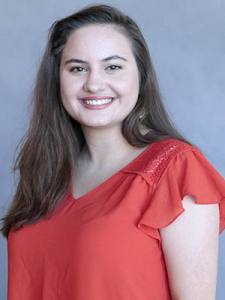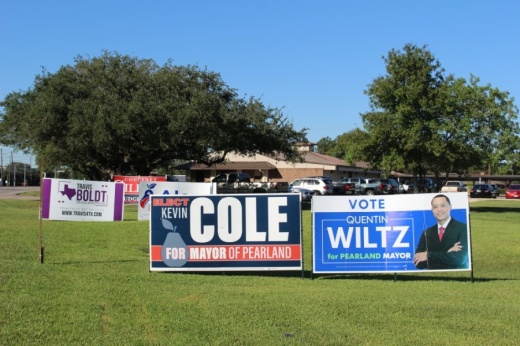One reason may be that in 2014, the county began to use vote centers, which allows citizens to vote anywhere in the county rather than confining them to their precinct to vote.
“It’s been very successful. I have had nothing but compliments from our community,” Brazoria County Precinct 4 Commissioner David Linder said.
While vote centers tend to lead to increased voter turnout, the system is not perfect, particularly if it involves cutting down the number of polling locations in the county, said Brandon Rottinghaus, a political science professor at the University of Houston.
“Vote centers are successful at turning out voters who are routine voters but less good at turning out less routine voters,” Rottinghaus said.
Vote centers increase turnout
Brazoria County began switching to vote centers after the state made a push toward all counties using vote centers. This is especially helpful for voters who may live in one part of the county and work in another, Brazoria County Election Director Lisa Mujica said. Mujica worked in the county prior to vote centers becoming widespread and has had citizens tell her it is easier to vote now.“I remember speaking to voters about getting to the polling location in a certain time frame and then finding out they had to go into their precinct. A lot of people were discouraged,” Mujica said.
For the 2012 presidential election, Brazoria County had over 60 polling locations. Since then, the county has slowly closed polling locations and opened a few new ones. The county is required to have 33 polling locations to adequately cover the county’s 66 voter precincts, and it did, at one time, drop below that requirement, said Kris McGarvey, chair for the Brazoria County Democrats. However, that problem was remedied the following year, she said. Having fewer polling places has not decreased engagement, McGarvey said.
“We haven’t seen a decrease in voter turnout; we have seen a massive increase in past years,” McGarvey said.
Roughly 59.62% of the county’s registered voters voted in the 2012 presidential election, which was before countywide vote centers were implemented. In 2016, roughly 61.53% of the county’s registered voters cast a ballot.
However, turnout may not rely simply on vote centers, Rottinghaus said. Presidential election years bring large amounts of voter engagement, no matter how many centers there are.
“There are a lot of caveats to voting centers being a boon for turnout,” Rottinghaus said.
Officials urge early voting
Brazoria County has 35 polling locations for Election Day. By comparison, Galveston County has 46 polling locations for Election Day. Galveston County also covers fewer miles than Brazoria County and has roughly 30,000 fewer residents.However, voters have an extra week of early voting this year, which McGarvey said she hopes residents use.
“It would be nice for poll workers if more people showed up during early voting,” she said.
The majority of Brazoria County voters have historically turned out at the polls during early voting and typically wait no more than 20 minutes at the polls, Mujica said. The longest wait on Election Day is typically an hour, she said.
Even if there is a line, Mujica said she finds voters would rather wait at a location they know rather than go to another one nearby.
“A lot of times, it is part of the community. They know the poll workers; they know the judges; they like to return to them,” she said.
Most people Green has talked to plan to vote in person, despite the possibility of lines.
“They do care about COVID, but their vote is important, and they want to make sure counts,” Green said.
Most of the polling locations with long wait times are in Pearland because of how populous the city is, Mujica said.
However, Pearland residents have not complained about long wait times, Precinct 3 Commissioner Stacy Adams said. Precinct 3 covers much of Pearland and has many polling locations for such a compact area, Adams said. During early voting, Pearland has three vote centers, and on Election Day, it will have 11.
“It’s hard during early voting to not pass by an early voting location,” Adams said. “I am glad to see more people.”
While the lines to vote are typically short in Brazoria County, elected officials and Rottinghaus warned of longer wait times this year because of the end of straight-party voting.
“What you don’t want on Election Day is a surprise. If they are surprised, they won’t vote,” Rottinghaus said.
The wait may also be longer due to the number of people who turn out this year. Linder said he has never seen so much excitement surrounding a presidential election.
“I think it’s awesome. I’ve never seen the enthusiasm. It’s almost every conversation,” he said.
In addition to national races, voters will see local candidates in November as well as candidates originally on the May ballot.
“There are a lot of smaller cities that had elections canceled, but in Pearland, there is drainage district, school board and city elections, not to mention the Pearland charter,” Adams said. “Bottom line, there will be more things to vote for.”
Attracting new voters
While vote centers can draw more of crowd, one of the biggest issues with them is that they mostly draw out regular voters, Rottinghaus said.“Consolidation of polling places takes voters out of the routine for them,” Rottinghaus said. “There are certain groups that may suffer in terms of turnout. Specifically, what you find is that when you increase differences, groups like Latinos are less likely to turn out.”
Rottinghaus, alongside UH political science professor Jeronimo Cortina, did a study on how vote centers affect turnout. One of their findings was that location makes a lot of the difference for voters, Rottinghaus said.
Precinct 4 covers a large portion of Brazoria County and includes residents from different demographics, from the most rural boundaries of the county to those who live west of Hwy. 288 in Pearland. While residents in rural areas have fewer vote centers available, they are the most loyal voters in the precinct, Linder said.
“Those people are easy to get out. They don’t wait for Election Day; they are there for early voting,” Linder said
It is much tougher to reach the voters west of Hwy. 288 near Pearland, Linder said. One reason might be that they work outside of the county, he said. Another reason is the voters are usually newer to town.
“A lot of candidates on the ballot have been here for generations. Their roots are deep,” Linder said.
Even though vote centers do make voting more convenient, they struggle to attract those who are new to town, especially when their use is coupled with there being fewer places to vote in the county, Rottinghaus said.
“Turnout may be good now, but not every election year will be like 2020,” he said. “The state is younger and becoming more ethnically and racially diverse. Those changes will manifest in elections where turnout may not be as strong in that group if other changes aren’t made.”





